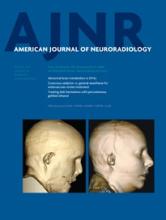Research ArticleNeurointervention
Silk Flow-Diverter Stent for the Treatment of Intracranial Aneurysms: A Series of 58 Patients with Emphasis on Long-Term Results
B. Lubicz, O. Van der Elst, L. Collignon, B. Mine and F. Alghamdi
American Journal of Neuroradiology March 2015, 36 (3) 542-546; DOI: https://doi.org/10.3174/ajnr.A4143
B. Lubicz
aFrom the Department of Neuroradiology (B.L., O.V.d.E., B.M., F.A.), Erasme University Hospital, Brussels, Belgium
O. Van der Elst
aFrom the Department of Neuroradiology (B.L., O.V.d.E., B.M., F.A.), Erasme University Hospital, Brussels, Belgium
L. Collignon
bDepartment of Radiology (L.C.), Centre Hospitalier Régional Citadelle, Liège, Belgium.
B. Mine
aFrom the Department of Neuroradiology (B.L., O.V.d.E., B.M., F.A.), Erasme University Hospital, Brussels, Belgium
F. Alghamdi
aFrom the Department of Neuroradiology (B.L., O.V.d.E., B.M., F.A.), Erasme University Hospital, Brussels, Belgium

REFERENCES
- 1.↵
- Molyneux A,
- Kerr R,
- Stratton I, et al
- 2.↵
- McDougall CG,
- Spetzler RF,
- Zabramski JM, et al
- 3.↵
- Cognard C,
- Pierot L,
- Anxionnat R, et al
- 4.↵
- Pierot L,
- Spelle L,
- Vitry F
- 5.↵
- Ferns SP,
- Sprengers MES,
- van Rooij WJ, et al
- 6.↵
- Pierot L,
- Cognard C,
- Anxionnat R, et al
- 7.↵
- Lubicz B,
- Collignon L,
- Raphaeli G, et al
- 8.↵
- Byrne JV,
- Beltechi R,
- Yarnold JA, et al
- 9.↵
- Tähtinen OI,
- Manninen HI,
- Vanninen RL, et al
- 10.↵
- Berge J,
- Biondi A,
- Machi P, et al
- 11.↵
- Wagner A,
- Cortsen M,
- Hauerberg J, et al
- 12.↵
- Velioglu M,
- Kizilkilic O,
- Selcuk H, et al
- 13.↵
- Cirillo L,
- Leonardi M,
- Dall'olio M, et al
- 14.↵
- 15.↵
- 16.↵
- Bonita R,
- Beaglehole R
- 17.↵
- Kamran M,
- Yarnold J,
- Grunwald IQ, et al
- 18.↵
- Kulcsár Z,
- Houdart E,
- Bonafé A, et al
- 19.↵
- Boddu SR,
- Tong FC,
- Dehkharghani S, et al
In this issue
American Journal of Neuroradiology
Vol. 36, Issue 3
1 Mar 2015
Advertisement
B. Lubicz, O. Van der Elst, L. Collignon, B. Mine, F. Alghamdi
Silk Flow-Diverter Stent for the Treatment of Intracranial Aneurysms: A Series of 58 Patients with Emphasis on Long-Term Results
American Journal of Neuroradiology Mar 2015, 36 (3) 542-546; DOI: 10.3174/ajnr.A4143
0 Responses
Jump to section
Related Articles
- No related articles found.
Cited By...
- First multicenter experience using the Silk Vista flow diverter in 60 consecutive intracranial aneurysms: technical aspects
- Review of current intracranial aneurysm flow diversion technology and clinical use
- Advances in endovascular aneurysm management: flow modulation techniques with braided mesh devices
- Periprocedural safety and technical outcomes of the new Silk Vista Baby flow diverter for the treatment of intracranial aneurysms: results from a multicenter experience
- Delayed parent artery occlusions following use of SILK flow diverters for treatment of intracranial aneurysms
- The occurrence of neointimal hyperplasia after flow-diverter implantation is associated with cardiovascular risks factors and the stent design
- Usefulness of Silent MR Angiography for Intracranial Aneurysms Treated with a Flow-Diverter Device
- Transient in-stent stenosis: a common finding after flow diverter implantation
- Transient in-stent stenosis at mid-term angiographic follow-up in patients treated with SILK flow diverter stents: incidence, clinical significance and long-term follow-up
- Expanding the use of flow diverters beyond their initial indication: treatment of small unruptured aneurysms
- Large Basilar Apex Aneurysms Treated with Flow-Diverter Stents
- Cerebral aneurysm treatment: modern neurovascular techniques
- Use of flow diverters in the treatment of unruptured saccular aneurysms of the anterior cerebral artery
- Treatment of Intra- and Extracranial Aneurysms Using the Flow-Redirection Endoluminal Device: Multicenter Experience and Follow-Up Results
- Mid-term and long-term follow-up of intracranial aneurysms treated by the p64 Flow Modulation Device: a multicenter experience
- Preclinical Testing of a Novel Thin Film Nitinol Flow-Diversion Stent in a Rabbit Elastase Aneurysm Model
- SILK flow diverter for complex intracranial aneurysms: a Canadian registry
This article has not yet been cited by articles in journals that are participating in Crossref Cited-by Linking.
More in this TOC Section
Similar Articles
Advertisement











